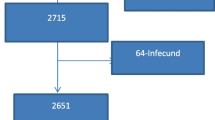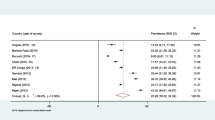Abstract
Pakistan is 5th most populous country in the world and striving to achieve population equilibrium. Unfortunately, one in five women in Pakistan has not been using contraceptives and thus bearing unwanted pregnancies. Female’s participation in their own matters and benefits from social, economic, and political spheres has remained very low. Gender inequality is often cited as a barrier to improving women’s sexual and reproductive health outcomes, including contraceptive use. Pakistan is ranked at 148th place out of the 149 countries in Global Gender Gap Report 2018, which indicates very high gender inequality. Keeping in view this fact, we investigated the impact of women’s decision-making autonomy on contraceptive use among married women age 15–49 years in Pakistan. Pakistan Demographic and Health Survey 2018 data has been used for analysis by using descriptive statistics, association tests, and multiple logistic regression. Women’s participation in making four household decisions: access to health care; large household purchases; what to do with the husband earning and freedom to visit family and relatives have been used as women’s decision-making autonomy. The results indicated that women’s decision-making autonomy has been positively associated with contraceptive use. Women’s age, province of residence, education level, household wealth status, number of children, time since last sex, and awareness about family planning services have also been found statistically significantly associated with contraceptive use. The current study suggests integrating the interventions for women's decision-making autonomy into family planning programs. For this purpose, the development of community-based awareness programs for women’s decision-making autonomy and contraceptive use could be useful interventions to achieve population equilibrium.
Similar content being viewed by others
References.
Ali, W., Fani, M. I., Afzal, S., & Yasin, G. (2010). Cultural barriers in women empowerment: A sociological analysis of Multan Pakistan. European Journal of Social Sciences, 18(1), 147–155.
Awusabo-Asare, K., Abane, A. M., & Kumi-Kyereme, A. (2004). Adolescent sexual and reproductive health in Ghana: A synthesis of research evidence. New York, NY: Alan Guttmacher Institute.
Bongaarts, J., & Sinding, S. W. (2009). A response to critics of family planning programs. International Perspectives on Sexual and Reproductive Health, 35(1), 39–44.
Chima, V., & Alawode, O. A. (2019). Modern contraceptive use among female adolescents in rural Nigeria: Does exposure to family planning messages matter? A cross-sectional study. Gates Open Research, 3(627), 627.
Desa, U. (2019). World Population Prospects 2019. United Nations. Department of Economic and Social Affairs. World Population Prospects 2019.
United Nations. Department of Economic and Social Affairs. (2019). World Population Prospects 2019.
Eliason, S., Baiden, F., Yankey, B. A., & Awusabo-Asare, K. (2014). Determinants of unintended pregnancies in rural Ghana. BMC Pregnancy and Childbirth, 14(1), 261.
Fawole, O. I., & Adeoye, I. A. (2015). Women’s status within the household as a determinant of maternal health care use in Nigeria. African Health Sciences, 15(1), 217–225.
Fayehun, O. A., Omololu, O. O., & Isiugo-Abanihe, U. C. (2011). Sex of preceding child and birth spacing among Nigerian ethnic groups. African Journal of Reproductive Heath, 15(2), 79–89.
Fikree, F. F., Khan, A., Kadir, M. M., Sajan, F., & Rahbar, M. H. (2001). What influences contraceptive use among young women in urban squatter settlements of Karachi, Pakistan? International Family Planning Perspectives, 27(3), 130–136.
Furuta, M., & Salway, S. (2006). Women’s position within the household as a determinant of maternal health care use in Nepal. International Family Planning Perspectives, 32, 17–27.
Haider, T. L., & Sharma, M. (2013). Barriers to family planning and contraception uptake in sub-Saharan Africa: A systematic review. International Quarterly of Community Health Education, 33(4), 403–413.
Hameed, W., Azmat, S. K., Ali, M., Sheikh, M. I., Abbas, G., Temmerman, M., & Avan, B. I. (2014). Women’s empowerment and contraceptive use: The role of independent versus couples’ decision-making, from a lower middle income country perspective. PLoS ONE, 9(8), e104633.
Islam, A. Z., Mondal, M. N. I., Khatun, M. L., Rahman, M. M., Islam, M. R., Mostofa, M. G., & Hoque, M. N. (2016). Prevalence and determinants of contraceptive use among employed and unemployed women in Bangladesh. International Journal of MCH and AIDS, 5(2), 92.
Kabeer, N. (1999). Resources, agency, achievements: Reflections on the measurement of women’s empowerment. Development and Change, 30(3), 435–464.
Kabeer, N., McFadden, P., Arnfried, S., Dominguez, E., & Saaadallah, S. (2001). Discussing women’s empowerment – theory and practice. Stockholm: Sida Studies.
Malhotra, A., Schuler, S. R., Boender, C. (2002). Measuring women’s empowerment as a variable in international development. In background paper prepared for the World Bank Workshop on Poverty and Gender: New Perspectives (Vol. 28).
Pakistan Demographic and Health Survey. (2018). National Institute of Population Studies, 2017-18.
Rob, A. U. (1990). Determinants of fertility in Bangladesh. Biology and Society, 7(1), 31–37.
Robinson, J. L., Narasimhan, M., Amin, A., Morse, S., Beres, L. K., Yeh, P. T., & Kennedy, C. E. (2017). Interventions to address unequal gender and power relations and improve self-efficacy and empowerment for sexual and reproductive health decision-making for women living with HIV: A systematic review. PLoS ONE, 12(8), e0180699.
Rutaremwa, G., Kabagenyi, A., Wandera, S. O., Jhamba, T., Akiror, E., & Nviiri, H. L. (2015). Predictors of modern contraceptive use during the postpartum period among women in Uganda: A population-based cross sectional study. BMC Public Health, 15(1), 262.
Sado, L., Spaho, A., & Hotchkiss, D. R. (2014). The influence of women’s empowerment on maternal health care utilization: Evidence from Albania. Social Science & Medicine, 114, 169–177.
Saleem, S., & Bobak, M. (2005). Women’s autonomy, education and contraception use in Pakistan: A national study. Reproductive Health, 2(1), 8.
Senarath, U., & Gunawardena, N. S. (2009). Women’s autonomy in decision making for health care in South Asia. Asia Pacific Journal of Public Health, 21(2), 137–143.
Stephenson, R., Baschieri, A., Clements, S., Hennink, M., & Madise, N. (2007). Contextual influences on modern contraceptive use in sub-Saharan Africa. American Journal of Public Health, 97(7), 1233–1240.
Tehrani, F. R., Farahani, F. K. A., & Hashemi, M. S. (2001). Factors influencing contraceptive use in Tehran. Family Practice, 18(2), 204–208.
The Global Gender Gap Report (2018). Geneva, Switzerland: World Economic Forum, 2018.
WHO, U. . (2010). UNFPA, world bank: Trends in maternal mortality: 1990 to 2008. UNICEF: Estimates developed by WHO.
Woldemicael, G. (2009). Women’s autonomy and reproductive preferences in Eritrea. Journal of Biosocial Science, 41(2), 161.
Woldemicael, G., & Beaujot, R. (2011). Currently married women with an unmet need for contraception in Eritrea: Profile and determinants. Canadian Studies in Population [ARCHIVES], 38(1–2), 61–81.
World Bank. (2018). World development indicators. The World Bank.
Wulifan, J. K., Mazalale, J., Jahn, A., Hien, H., Ilboudo, P. C., Meda, N., & De Allegri, M. (2017). Factors associated with contraceptive use among women of reproductive age in rural districts of Burkina Faso. Journal of Health Care for the Poor and Underserved, 28(1), 228–247.
Author information
Authors and Affiliations
Corresponding author
Additional information
Publisher's Note
Springer Nature remains neutral with regard to jurisdictional claims in published maps and institutional affiliations.
Rights and permissions
About this article
Cite this article
Nadeem, M., Malik, M.I., Anwar, M. et al. Women Decision Making Autonomy as a Facilitating Factor for Contraceptive Use for Family Planning in Pakistan. Soc Indic Res 156, 71–89 (2021). https://doi.org/10.1007/s11205-021-02633-7
Accepted:
Published:
Issue Date:
DOI: https://doi.org/10.1007/s11205-021-02633-7




